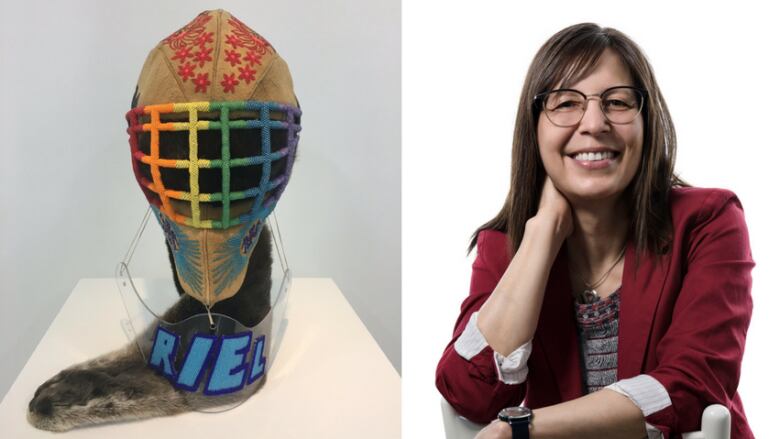Beadwork goalie mask wins Salt Spring National Art Prize for Calgary professor
3D installation combined traditional beading, moose hide, otter skin

Calgary-based artist Judy Anderson has won the Salt Spring National Art Prize for a 3D mixed-media piece that combines traditional Cree beadwork, moose hide, otter skin and a goalie mask.
Anderson was one of 49 finalists with her work, titled This one brings me the most pride.
Anderson, who is Cree from Saskatchewan's Gordon First Nation, is an assistant art professor at the University of Calgary, where she teaches Indigenous art history, beadwork and quilling.
She began working on the piece during an international artist's residency in New York. It took three months of full-time work to complete.
- MORE ALBERTA NEWS | Alberta schools to teach Indigenous history and culture, education minister announces
The Joan McConnell Award for Outstanding Work, which includes $12,000 cash and $5,000 toward an artist's residency on Salt Spring Island, B.C., was presented to Anderson at an awards gala on Saturday.
Anderson told CBC News that the piece was inspired by the opportunity to honour the people in her life.
She often creates art with her older son, Cruz, combining his interest in graffiti with her talent for traditional beading.
So, this piece was a chance for her to spotlight her youngest, 14-year-old Riel, who plays hockey and is "quite good" at it, according to Anderson.
"The basis of it is love," she said in a phone interview.
"It was all about the love and who he [Riel] is as a human being."
She described her art in a release as "deeply personal with a focus on issues of spirituality, family, graffiti and popular representations of Aboriginal people."
Anderson was home with her family when she learned she had won the top prize, she said.
"When I visited the opening exhibition in September there were so many works I admired that I had no inkling I would win," she said.
Anderson's work, along with art from the other winners, will be exhibited at Vancouver's Bau-Xi Gallery from Nov. 4 to 18.
Competition is judged anonymously
The biennial art competition, which is in its second year, offers eight awards totaling $30,000.
The 1,227 contemporary artists who submitted 2,160 pieces of work hailed from across Canada.
The artists' names and cities they reside in were not disclosed to the jury — ensuring there was no bias toward recognized artists or artists from major cities.
"Sometimes it's not always about the art, it's about the name. So when you say a big name like 'Van Gogh,' everyone is like, 'OK, I expect that to be really, really good.' So in this way, they just look at the art and they judge it that way," Anderson said.

The competition's founding director, Ronald T. Crawford, told CBC Arts in advance of the inaugural competition in 2015 that hosting an anonymous national art competition on the tiny island of just 10,000 inhabitants near Victoria, B.C., allows for the "decentralizing" of art.
"It was important to me as an artist because that puts the art in the foreground.... I felt that every artist across the country has an equal opportunity," he said.
This year, the competition was juried by Naomi Potter, director/curator of the Esker Foundation in Calgary; Denis Longchamps, artistic director and chief curator at the Art Gallery of Burlington; and David Garneau, associate professor of visual arts at the University of Regina.
- MORE CALGARY NEWS | Hearings begin on fate of wetlands impacted by Calgary ring road
- MORE CALGARY NEWS | Chef David Wolfman explores Indigenous cuisine in new cookbook